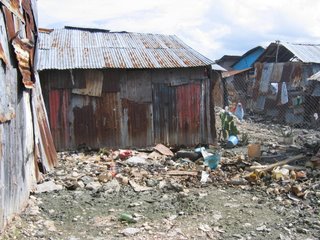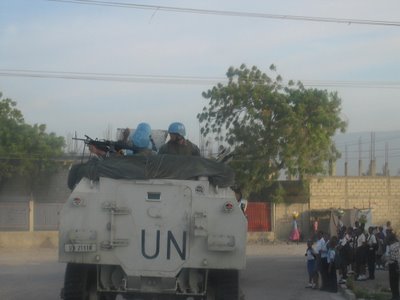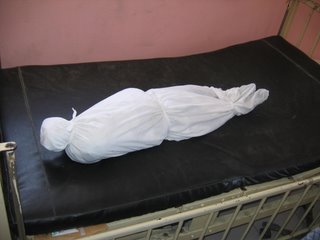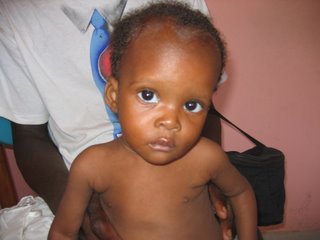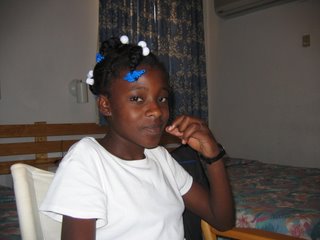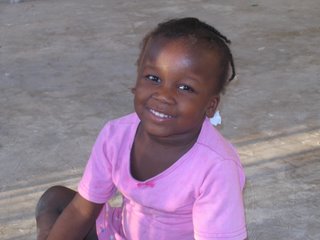

The Story of Willy Malavolti (AKA Willy Fortune):
The children above and to the right are Willy's fellow citzens, who are sick right now in Haiti.
John met Willy Fortune about eight years ago in Haiti. His mother lugged the playful boy with the blue lips up the mountain to the hospital above Les Cayes, where John worked. John could tell by Willy’s look and the sound of his heart, which for starters, was located on the wrong side of his chest, that he had congenital heart disease. An echocardiogram in Port-au-Prince revealed Willy to have multiple serious heart problems, including transposition of the great vessels. Children with only this defect never live to the age of 10, but some of Willy’s other defects were offsetting the transposition enough that he was still alive, though blue.
Physicians at OSF St. Francis Medical Center reviewed the echo and medical history of Willy and decided they could help him. In 1999, Willy flew to the United States and had the first of his two heart surgeries to repair some of his defects. There were major complications, and he spent five months in intensive care. During the second surgery, Willy had to have a pacemaker put in to regulate his heart beat because his conduction system, the electrical portion of the heart that controls the beat, was damaged. After he recovered, Willy was discharged a much healthier boy. He flew to Boston to be with his father. Some time later, his father flew Willy back to Haiti, where he lived with his mom and sisters in two room cinder block house on the side of a mountain.
John was fired from OSF in December 2001. About a year later, OSF ended its involvement with Haitian Hearts. During John’s frequent trips to Haiti after Willy returned, he examined Willy and took him medicines. In January 2004, on a trip to Haiti, when John examined Willy, his heart would only beat 60 times a minute no matter what his activity level. Willy’s pacemaker had a five year battery in it and it was getting close to the end of its life, so it was conserving energy. John e-mailed OSF and asked if they would replace Willy’s pacemaker battery, a relatively minor but crucial heart procedure. He offered to pay for the procedure. OSF refused and their attorney sent a letter saying that they wouldn’t accept any of John’s Haitian patients because of his attempts to embarrass the hospital through his picketing.
John returned to Haiti in March. Willy’s mom told John that Willy had almost died and was very weak. A physician friend of John’s was able to get Willy accepted by a hospital in Tennessee. In May 2004, Willy ultimately had a new pacemaker put in his heart at Vanderbilt Children’s Hospital in Nashville. His Peoria host family then flew him to Peoria for John’s and my wedding. After we returned from our honeymoon, Willy came to live with us for a few weeks. We knew that his chances at continuing good health were not good in Haiti, so we decided to search for an adoptive home for Willy.
Rose and Al Malavolti answered an ad John’s mom placed in a national Catholic newspaper. An experienced adoptive couple, they came to our condo with some of their many, well-behaved children. Like most people, they fell in love with Willy. A couple weeks later, he went to live with them. In the past two years, Willy, who due to his severe heart condition, spent no time in school in Haiti, learned to read. He also became Catholic. He is now surrounded by 14 brothers and sisters, six of them Haitian also, who along with his parents have given him a wonderful family.
As we gathered the necessary legal papers for the adoption, a finalization date was scheduled for July 5, 2006. In the spring of 2005, Willy began to retain fluid in his abdomen. In June, his parents took him to a pediatric cardiologist in Rockford, where they live. The doctor examined Willy and said because of his complex history and anatomy, he would be best served by going to Chicago or to OSF in Peoria where the doctors were familiar with his case. John spoke with pediatric cardiologist Dr. Doug Schneider who said he would see Willy.
The Malavolti’s drove Willy to Peoria on June 21, 2006. He was admitted to the hospital through the emergency department. An echocardiogram revealed that he has two leaky valves, causing his poor heart function. A cardiac catherization indicated that his heart is likely strong enough to withstand the assault of surgery. What is known for certain is that without surgery, Willy will soon die. He will hopefully have surgery later this month. The oxygen, IV medications and nutrients, and constant monitoring are currently keeping him alive.
It has been a tough road for Willy, but we believe that God is giving us signs that things are proceeding as they should. A big one is that he is at OSF St. Francis Medical Center. After refusing him two years ago, the hospital accepted Willy as a patient. He has insurance through his parents and he came in through the emergency department. Plus, he is probably not considered a Haitian Hearts patient anymore. Whatever the reasons, it’s good that he is there as the doctors in the pediatric cardiac practice are the most familiar with Willy’s complicated heart.
Due to his fragile health, Willy has had his ups and downs during his hospitalization. As the adoption date of July 5 approached, it became apparent that Willy would not be able to leave the hospital for the courtroom hearing. The family’s attorney, Willy’s court appointed attorney, his parents, and I all met in the courtroom at the appointed time. Because of Willy’s condition, the judge said he would go to OSF later that evening and do the adoption.
At 5:30 pm, the same players along with a court reporter, all assembled in room G218 of the Pediatric Intermediate Care Unit (PICU). Willy’s sister Ann and brother Pascal were also present. After a brief hearing and amid many smiles, the judge signed the adoption order. There were hugs all around. The most crazily optimistic or imaginative person in the world could not have predicted two years ago that Willy would not only be hospitalized at OSF, but he would be adopted there. Only God could have thought up this one.
John and I have been to visit Willy several times while he has been hospitalized. During one of our first visits, John commented that the wooden carved statue of Blessed Mother Mary from Haiti that he had given OSF back in the good old days as a thanks for caring for Haitian children was not in its usual place. In fact, John did not see it anywhere. We both felt sad about this.
A little over a week ago, we went to see Willy on a Sunday evening. It would be our last visit before we left for out Haiti trip. A couple of days before, Willy had been once again moved to ICU as he had had problems breathing. On this evening, he was stable and the swelling in his legs decreased. We joked and talked with him for a few minutes and then said good bye. Across from Willy’s room was a small, no longer used nurse’s station. “There’s the statue,” said John and I looked up to see a light brown wooden statue of Mary, surrounded by several children, on a table against the wall of the station. She was facing diagonally, looking directly into Willy’s room.
We do not know what the outcome will be for Willy at OSF St. Francis Medical Center, but we are grateful to the forces that allow him to be there. Willy wants to live and has emphatically said that he wants surgery. He knows it will be high risk. Please keep him in your prayers


















